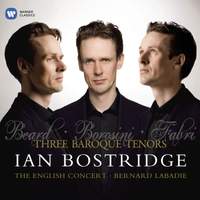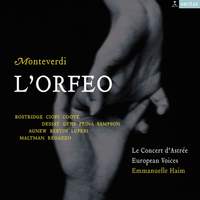Interview,
Ian Bostridge on Tormento d'amore
 Featuring arias from rarities such as Vinci's Il Siroe, Cavalli's Eliogabalo, Cesti's Berenice and Stradella's Il Corispero, Ian Bostridge's new album Tormento d'amore (released last month on Warner Classics) shines a welcome spotlight on the role of the tenor voice in Italian opera of the seventeenth and early eighteenth centuries - a period when sopranos and altos of both sexes tended to take centre-stage...
Featuring arias from rarities such as Vinci's Il Siroe, Cavalli's Eliogabalo, Cesti's Berenice and Stradella's Il Corispero, Ian Bostridge's new album Tormento d'amore (released last month on Warner Classics) shines a welcome spotlight on the role of the tenor voice in Italian opera of the seventeenth and early eighteenth centuries - a period when sopranos and altos of both sexes tended to take centre-stage...
Over video-call last month, I spoke to Ian about why he views this stage in operatic history as a 'period of fluidity' on various levels, the contrasts between the arias on the album and the more flamboyant display-pieces written for the star castrati of the age, and how his background in Lieder and more recent forays into jazz both informed his perspective on this music.
Your 2010 album Three Baroque Tenors focused on a trio of star singers: John Beard, Francesco Borosini and Annibale Po Fabri. How much do we know about the singers who created the roles on the new recording?
Not a great deal, actually! Whereas that previous disc which was very much about specific individuals, this one was generated by the conductor Antonio Florio, who put together this programme to show the relationship between the Neapolitan and Venetian operatic worlds in the seventeenth and eighteenth centuries. I have a wonderful Italian agent called Mario Ingrassia, and he’d always wanted to put me together with Antonio; Antonio had been working on the project for a long time, and the programme on the album started out as a concert that we did in Italy.
Did you feel that the influence of composers from either city dominated, or was the relationship more reciprocal?
I found they influenced each other, really; their works were performed in different cities and they had very individual voices. I’d say it’s a period of fluidity, in so many ways – in terms of the development of tonality, but also the formal structure of arias. It’s interesting that in some of the pieces here the form hadn’t yet solidified into the classic da capo aria which we hear in something like Vivaldi’s Gelido in ogni vena, which I think is the greatest piece on the album. I suppose ‘chromaticism’ isn’t really the right word in this context, because tonality hadn’t really solidified either at that point, but the use of dissonance in that aria is quite startling: it’s a very powerful piece of word-setting and has this extraordinary sense of stasis, of being frozen, which is obviously related to ‘Winter’ in Vivaldi’s Four Seasons.
...and so different from Leonardo Vinci’s setting of the same text…
Very different indeed – that’s a much more melodic aria altogether, and the mood is calmer and more reflective.
Almost twenty years ago, you recorded the title-role in Monteverdi’s Orfeo with Le Concert d`Astrée and Emmanuelle Haïm – did you feel that the sound-world of that particular work influenced any of the composers we meet on the new album?
I wouldn’t say that Orfeo specifically came to mind. Monteverdi himself is clearly a massive influence on a lot of this music, but there’s such an enormous difference between the Orfeo Monteverdi and the Venetian Monteverdi, both in terms of the audience that he’s appealing to and in terms of the sheer range of orchestral colours. One of the great things about Orfeo is its extraordinary orchestration, and that’s something that we don’t really have in the Venetian works, where the palette is necessarily much more limited.
When we spoke to your fellow Warner/Erato tenor Michael Spyres about his own forthcoming album of baroque opera arias last September, he mentioned that distinctions between the tenor and baritone voice during this period were a lot less rigid than they are today – was that something which you also found to be true when exploring the repertoire for this recording?
The tessitura for most of the music on the album is certainly very much middle-of-the-voice, and one of the appeals of these arias for me is that they essentially sit in the same tessitura as lieder, which is all about the delivery of text in a speaking register. Tessitura in this period was influenced by a combination of things, I think: the size of the audiences, the degree of intimacy, and the nature of the roles themselves. And the vast majority of roles on the album are quite different from the virtuoso display roles that were taken on by both sexes during this period.
I’ve been thinking about this quite a bit lately, because I’ve been singing a lot of jazz and jazz-influenced music: I’ve been working with Brad Mehldau, doing a cycle he wrote for us to perform together called Folly of Desire which has got a lot of pop influences, and also doing some jazz standards. I’m reminded of something William Christie said a long time ago: that a lot of this music is more like jazz than what we think of as operatic music.
So often when we’re talking about lieder we have this weird, self-denying idea that lieder is all about words and not about voice, and I don’t think that’s it at all. With lieder and with this particular sort of operatic music, it’s actually about how the words are set, and that allows one to inflect the music in a way that’s more like jazz. If you look at the way that someone like Billie Holiday uses words, it’s not so much about the meaning of the words themselves - these aren’t necessarily great poems - but rather about different vowel and consonants creating different sounds, as opposed to the rather relentless sound of the operatic world.
Might more baroque and early Classical opera figure in your future?
I hope so: I’m doing some Gluck for the first time in Paris this autumn, singing Renaud in Armide with Christophe Rousset. Most of the operas on this disc have never been recorded, but there’s so much to discover from this period in terms of chamber music as well – particularly some cantatas which have been on my mind for a while but which I’ve never quite got round to doing. I did a Wigmore Hall residency quite a long time ago and I found some wonderful cantatas by Alessandro Scarlatti: one on Orfeo and one on Nerone. There’s just a huge amount of this stuff out there, including a number of Handel cantatas that are only done very rarely, and once everyone gets back on their feet after everything that’s been going on over the last couple of years it would be great to explore that.
Ian Bostridge (tenor), Cappella Neapolitana, Antonio Florio
Available Formats: CD, MP3, FLAC, Hi-Res FLAC, Hi-Res+ FLAC
Ian Bostridge (tenor), The English Concert, Bernard Labadie
Available Formats: MP3, FLAC
Ian Bostridge (Orfeo), Natalie Dessay (La Musica), Patrizia Ciofi (Euridice), Véronique Gens (Proserpina), Alice Coote (Messaggiera), Sonia Prina (Speranza), Carolyn Sampson (Ninfa), Paul Agnew (Eco/Pastore), Christopher Maltman (Apollo/Pastore), Lorenzo Regazzo (Plutone)
Le Concert d'Astrée, Emmanuelle Haïm
Available Formats: MP3, FLAC





